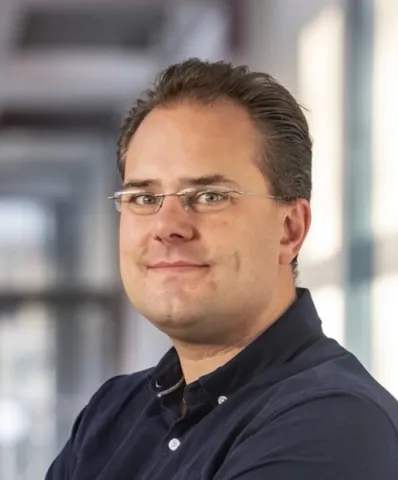Project overview
X-ray imaging technology is increasingly used for specialised non-destructive testing and measurement applications, especially in high value and safety/performance critical industries, such as defence or aerospace. Current tomographic methods, which can image detailed internal geometries, require x-ray images to be taken from angles evenly spaced around the object under investigation. However, problems arise because 1) x-ray penetration depth is limited and 2) different materials absorb x-rays in varying amounts. Thus, large objects such as larger panels or assemblies with materials with widely varying x-ray absorption profiles can thus often not be imaged with these techniques, even if x-ray penetration is possible in some directions and through some materials.
The inspection of many composite components encountered in aerospace structures is not currently feasible with traditional x-ray imaging techniques, either due to their high aspect ratio or due to the presence of highly absorbing metal structures. Yet owing to their safety critical function, such components often need to be inspected regularly for internal defects using non-destructive testing methods. Current non-destructive inspection approaches, however, are often not applicable. For example, ultrasound testing can often not be applied to many advanced composite materials whilst thermography has limited depth capability. For such composite materials, x-ray based techniques remain one of the few alternatives if these materials are to be used to their full potential in future aerospace design.
Building on a current project in which we are developing x-ray imaging hardware that allows us to scan flat panel carbon fibre structures with unconventional scan trajectories, the current proposal aims at the development of new computational methods to recover the three dimensional x-ray absorption profile from the x-ray measurements made with our new system. Current experiments using traditional methods have shown that available x-ray tomography reconstruction algorithms perform poorly in scan settings where a component cannot be scanned from all directions. This is due to a fundamental physical limitation of the system, which is just not able to acquire enough information to allow good reconstructions. This fundamental limit can only be overcome if we can introduce additional information into the reconstruction.
For nearly all modern manufactured components, such information is luckily available in the form of detailed CAD drawings and it is this information we propose to use to overcome the x-ray tomographic reconstruction problem.
In particular, we will address the following problems.
1) Design a reconstruction algorithm that uses CAD drawings as prior information in order to directly estimate object boundaries.
2) Allow the estimated surface to be close to, but not necessarily identical to the surfaces predicted by the CAD model.
3) Only once object boundaries have been estimated, use a second reconstruction step to estimate the spatial distribution of x-ray absorption.
4) Use a multigrid approach to increase computational efficiency of the method
To design lighter, cheaper and more efficient airplanes, many components need to become lighter and cheaper whilst still satisfying strict performance standards. This can often be achieved using modern composite materials. As the use of these components is safety critical, reliable inspection methods are required if these components are to be used.
The inspection of many composite components encountered in aerospace structures is not currently feasible with traditional x-ray imaging techniques, either due to their high aspect ratio or due to the presence of highly absorbing metal structures. Yet owing to their safety critical function, such components often need to be inspected regularly for internal defects using non-destructive testing methods. Current non-destructive inspection approaches, however, are often not applicable. For example, ultrasound testing can often not be applied to many advanced composite materials whilst thermography has limited depth capability. For such composite materials, x-ray based techniques remain one of the few alternatives if these materials are to be used to their full potential in future aerospace design.
Building on a current project in which we are developing x-ray imaging hardware that allows us to scan flat panel carbon fibre structures with unconventional scan trajectories, the current proposal aims at the development of new computational methods to recover the three dimensional x-ray absorption profile from the x-ray measurements made with our new system. Current experiments using traditional methods have shown that available x-ray tomography reconstruction algorithms perform poorly in scan settings where a component cannot be scanned from all directions. This is due to a fundamental physical limitation of the system, which is just not able to acquire enough information to allow good reconstructions. This fundamental limit can only be overcome if we can introduce additional information into the reconstruction.
For nearly all modern manufactured components, such information is luckily available in the form of detailed CAD drawings and it is this information we propose to use to overcome the x-ray tomographic reconstruction problem.
In particular, we will address the following problems.
1) Design a reconstruction algorithm that uses CAD drawings as prior information in order to directly estimate object boundaries.
2) Allow the estimated surface to be close to, but not necessarily identical to the surfaces predicted by the CAD model.
3) Only once object boundaries have been estimated, use a second reconstruction step to estimate the spatial distribution of x-ray absorption.
4) Use a multigrid approach to increase computational efficiency of the method
To design lighter, cheaper and more efficient airplanes, many components need to become lighter and cheaper whilst still satisfying strict performance standards. This can often be achieved using modern composite materials. As the use of these components is safety critical, reliable inspection methods are required if these components are to be used.
Staff
Lead researchers
Other researchers
Collaborating research institutes, centres and groups
Research outputs
Yushan Gao & Thomas Blumensath,
2018, IEEE Transactions on Computational Imaging, 4(4), 599-608
Type: article
